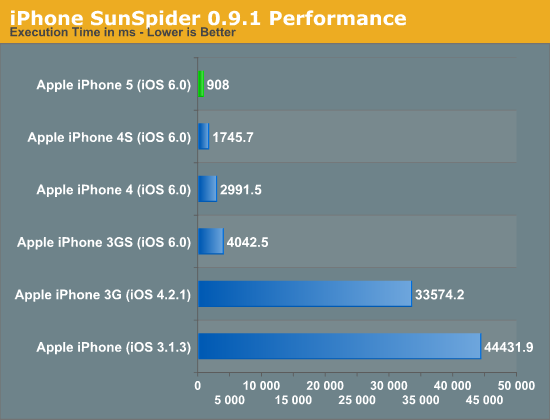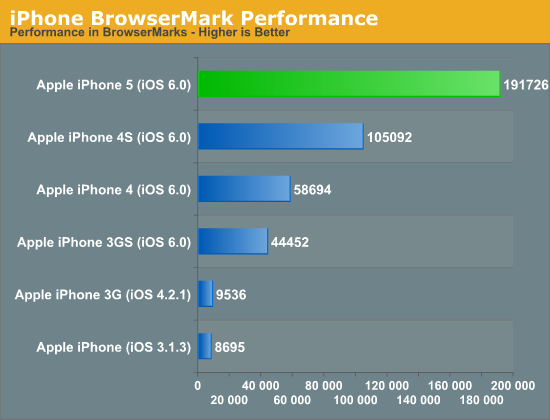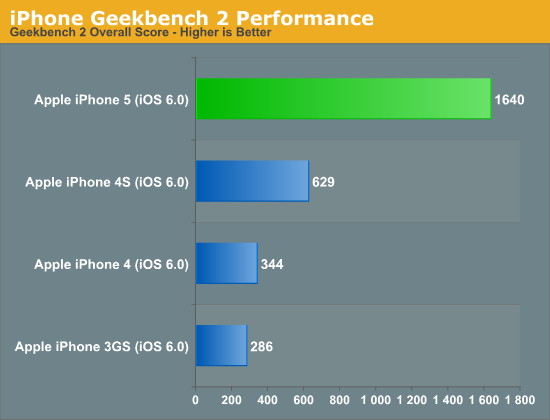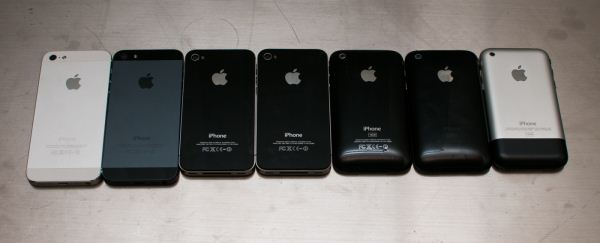The iPhone 5 Review
by Anand Lal Shimpi, Brian Klug & Vivek Gowri on October 16, 2012 11:33 AM EST- Posted in
- Smartphones
- Apple
- Mobile
- iPhone 5
Six Generations of iPhones: Performance Compared
Section by Anand Shimpi
Cross platform smartphone benchmarks are interesting, but they do come with their own sets of issues. Before we get to that analysis however, let's look at how the iPhone's performance has improved over the past six generations. Luckily Brian has a set of all of the iPhones so he was able to run a few tests on all of the devices, each running the latest supported OS.
We'll start with SunSpider 0.9.1, our trusty javascript performance test:

The transition from iPhone to iPhone 3G shows you just how much additional performance you can squeeze out of simply a software change. There's likely even more that could be squeezed out of that ARM11 platform, unfortunately newer versions of Safari/iOS aren't supported on the iPhone 3G so we're left with a runtime that's around 37x the length of a single run on the iPhone 5.
The rest of the devices support and run iOS 6, so we're at least on a level software playing field. The performance boost from one generation to the next is quite significant still. Going by this chart alone, the best balance of minimal upgrades and maximum perceived improvement would be from the original iPhone to the 3GS then again from the 3GS to the 5.

The BrowserMark results tell a similar story. The jump from the ARM11 based iPhone/iPhone 3G to the 3GS running iOS 6 is huge. Both the 4S and 5 offer doublings in performance, albeit for different reasons. The 4S delivered a doubling thanks to a doubling of core count and a move to the Cortex A9, while the iPhone 5 doubled performance through a much higher clock speed and microarchitectural improvements.
Finally we have Geekbench 2, which only runs on the iOS 6 supported devices so we say goodbye to the original iPhone and iPhone 3G:

None of the jumps looks as dramatic as the move to the iPhone 5, but we already know why. The Swift CPU architecture does a great job improving memory performance, which shows up quite nicely in a lot of the Geekbench 2 subtests.
On the PC side we often talk about 20% performance improvements from one generation to the next being significant. It's clear that the mobile SoC space is still operating along a hyper Moore's Law curve. The rate of progress will eventually slow down, but I don't see that happening for at least another couple generations. The move to ARM's Cortex A15 will be met with another increase in performance (and a similarly large set of power challenges), and whatever comes next will push smartphones into a completely new category of performance.












276 Comments
View All Comments
OldAndBusted - Wednesday, October 24, 2012 - link
"I'm not an apple product owner, and never plan to be"That's actually kind of sad. That no matter what the product, you can't even consider it if it comes from Apple.
SolidusOne - Saturday, October 20, 2012 - link
How can you write page after page about geeky nuances, many of which cannot be discerned without lab equipment, and not utter a single word about the device's music player quality? This model particularly, as other reviews have said it was inferior to 4s in audio quality. ??????phillyry - Sunday, October 21, 2012 - link
Sorry but are you serious or trolling?Google search reveals nothing about this.
If you're serious then Engadget has an article for you that compares the sound quality of iPhone 5, GS3, One X, etc. with basically no appreciable difference. http://www.engadget.com/2012/10/02/iphone-vs-rival...
mshdk - Sunday, October 21, 2012 - link
What is the name of the IM app shown in the review?mohit2805 - Sunday, October 21, 2012 - link
Why Apple never goes for an inbuilt radio? why just its own ipod, when there are so many radio stations to listen to for free?Krysto - Tuesday, October 23, 2012 - link
The new Chromebook, which has a dual core 1.7 Ghz Cortex A15 CPU, reaches 668 points in Sunspider. That's compared to the 900+ for Apple's A6.darkcrayon - Wednesday, January 2, 2013 - link
Comparing a chip in a laptop to one in a smartphone.. A laptop with terrible battery life (for an ARM device) at a that. Nice work. Let us know when Apple puts an Ax chip inside of a small laptop and then let's compare performance.eanazag - Thursday, November 1, 2012 - link
I live in MN and have been using the maps app in iOS 6 on an iPhone 4 and iPad 3. I have encountered no issues with it. In fact it has been a little more accurate than the GPS I have and Google previously. I am guessing that in more urban areas there is a larger difference.I would have liked to see some more features that my GPS has, such as current speed, estimated arrival time, and remaining total miles for trip.
If I'm going to complain, wish they would have included turn-by-turn on the 4.
Coffeebean20 - Saturday, November 24, 2012 - link
Wow great review, I got my iPhone 5 free And tested it. I came up with similar results. Great review, good job :)cpu_arch - Wednesday, November 28, 2012 - link
Your block diagram of Swift is inaccurate, not because I know the block diagram of the Swift CPU, but because it fails to describe the basic out-of-order execution pipeline of any modern CPU's. Hint: instruction re-ordering is in the wrong place in your diagram.Your measurements of branch prediction microarchitecture performance are not useful. The key measurement is mispredict rate.
Also modern branch prediction is a function of branch outcome of the branch in question and prior branches, not some multiply/divide mechanism which you describe in your article.